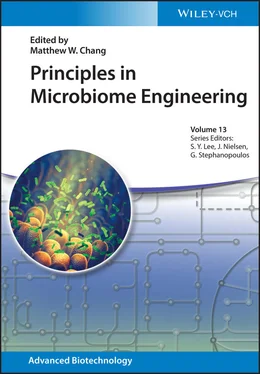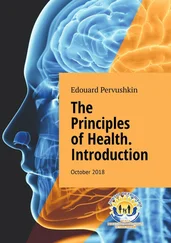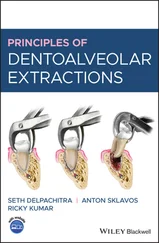Principles in Microbiome Engineering
Здесь есть возможность читать онлайн «Principles in Microbiome Engineering» — ознакомительный отрывок электронной книги совершенно бесплатно, а после прочтения отрывка купить полную версию. В некоторых случаях можно слушать аудио, скачать через торрент в формате fb2 и присутствует краткое содержание. Жанр: unrecognised, на английском языке. Описание произведения, (предисловие) а так же отзывы посетителей доступны на портале библиотеки ЛибКат.
- Название:Principles in Microbiome Engineering
- Автор:
- Жанр:
- Год:неизвестен
- ISBN:нет данных
- Рейтинг книги:5 / 5. Голосов: 1
-
Избранное:Добавить в избранное
- Отзывы:
-
Ваша оценка:
- 100
- 1
- 2
- 3
- 4
- 5
Principles in Microbiome Engineering: краткое содержание, описание и аннотация
Предлагаем к чтению аннотацию, описание, краткое содержание или предисловие (зависит от того, что написал сам автор книги «Principles in Microbiome Engineering»). Если вы не нашли необходимую информацию о книге — напишите в комментариях, мы постараемся отыскать её.
Provides an overview of the techniques and applications insight into the complex composition and interactions of microbiomes Principles in Microbiome Engineering
Principles in Microbiome Engineering
Principles in Microbiome Engineering — читать онлайн ознакомительный отрывок
Ниже представлен текст книги, разбитый по страницам. Система сохранения места последней прочитанной страницы, позволяет с удобством читать онлайн бесплатно книгу «Principles in Microbiome Engineering», без необходимости каждый раз заново искать на чём Вы остановились. Поставьте закладку, и сможете в любой момент перейти на страницу, на которой закончили чтение.
Интервал:
Закладка:
45 45 Turnbaugh, P.J., Hamady, M., Yatsunenko, T., et al. (2009). A core gut microbiome in obese and lean twins. Nature 457 (7228): 480–484.
46 46 Preidis, G.A. and Versalovic, J. (2009). Targeting the human microbiome with antibiotics, probiotics, and prebiotics: gastroenterology enters the metagenomics era. Gastroenterology 136 (6): 2015–2031.
47 47 Dewulf, E.M., Cani, P.D., Claus, S.P., et al. (2013). Insight into the prebiotic concept: lessons from an exploratory, double blind intervention study with inulin‐type fructans in obese women. Gut 62 (8): 1112–1121.
48 48 Petschow, B., Doré, J., Hibberd, P., et al. (2013). Probiotics, prebiotics, and the host microbiome: the science of translation. Ann. N. Y. Acad. Sci. 1306 (1): 1–17.
49 49 Wieërs, G., Belkhir, L., Enaud, R., et al. (2020). How probiotics affect the microbiota. Front. Cell. Infect. Microbiol. 9: 454–454.
50 50 Mandel, D.R., Eichas, K., and Holmes, J. (2010). Bacillus coagulans: a viable adjunct therapy for relieving symptoms of rheumatoid arthritis according to a randomized, controlled trial. BMC Complement. Altern. Med. 10: 1.
51 51 Hempel, S., Newberry, S., Ruelaz, A., et al. (2011). Safety of probiotics used to reduce risk and prevent or treat disease. Evid. Rep. Technol. Assess. (Full Rep.) 200: 1–645.
52 52 Hempel, S., Newberry, S.J., Maher, A.R., et al. (2012). Probiotics for the prevention and treatment of antibiotic‐associated diarrhea: a systematic review and meta‐analysis. JAMA 307 (18): 1959–1969.
53 53 Zarrinpar, A., Chaix, A., Yooseph, S., et al. (2014). Diet and feeding pattern affect the diurnal dynamics of the gut microbiome. Cell Metab. 20 (6): 1006–1017.
54 54 David, L.A., Maurice, C.F., Carmody, R.N., et al. (2014). Diet rapidly and reproducibly alters the human gut microbiome. Nature 505 (7484): 559–563.
55 55 Shi, W., Qi, H., Sun, Q., et al. (2018). gcMeta: A global catalogue of metagenomics platform to support the archiving, standardization and analysis of microbiome data. Nucleic Acids Res. 47 (D1): D637–D648.
56 56 Dhariwal, A., Chong, J., Habib, S., et al. MicrobiomeAnalyst ‐ a web‐based tool for comprehensive statistical, visual and meta‐analysis of microbiome data. Nucleic Acids Res. 45: W180–W188.
57 57 Patel, J.B. (2001). 16S rRNA gene sequencing for bacterial pathogen identification in the clinical laboratory. Mol. Diagn. 6 (4): 313–321.
58 58 Wang, Q., Garrity, G.M., Tiedje, J.M., et al. (2007). Naïve Bayesian classifier for rapid assignment of rRNA sequences into the new bacterial taxonomy. Appl. Environ. Microbiol. 73 (16): 5261–5267.
59 59 Weisburg, W.G., Barns, S.M., Pelletier, D.A., et al. (1991). 16S ribosomal DNA amplification for phylogenetic study. J. Bacteriol. 173 (2): 697–703.
60 60 Hasan, N.A., Young, B.A., Minard‐Smith, A.T., et al. (2014). Microbial community profiling of human saliva using shotgun metagenomic sequencing. PLoS One 9 (5): e97699.
61 61 Segata, N., Waldron, L., Ballarini, A., et al. (2012). Metagenomic microbial community profiling using unique clade‐specific marker genes. Nat. Methods 9 (8): 811–814.
62 62 Turnbaugh, P.J., Ridaura, V.K., Faith, J.J., et al. (2009). The effect of diet on the human gut microbiome: a metagenomic analysis in humanized gnotobiotic mice. Sci. Transl. Med. 1 (6): 6ra14.
63 63 Szakály, Z., Szente, V., Kövér, G., et al. (2012). The influence of lifestyle on health behavior and preference for functional foods. Appetite 58 (1): 406–413.
64 64 Zhao, J., Zhang, X., Liu, H., et al. (2019). Dietary protein and gut microbiota composition and function. Curr. Protein Pept. Sci. 20 (2): 145–154.
65 65 Fan, P., Liu, P., Song, P., et al. (2017). Moderate dietary protein restriction alters the composition of gut microbiota and improves ileal barrier function in adult pig model. Sci. Rep. 7 (1): 43412.
66 66 Karen, L.J. (1999). Small intestinal bacterial overgrowth. Vet. Clin. North Am. Small Anim. Pract. 29 (2): 523–550.
67 67 Mayneris‐Perxachs, J., Bolick, D.T., Leng, J., et al. (2016). Protein‐ and zinc‐deficient diets modulate the murine microbiome and metabolic phenotype. Am. J. Clin. Nutr. 104 (5): 1253–1262.
68 68 Singh, R.K., Chang, H.W., Yan, D.I., et al. (2017). Influence of diet on the gut microbiome and implications for human health. J. Transl. Med. 15 (1): 73.
69 69 Reddy, B.S., Weisburger, J.H., and Wynder, E.L. (1975). Effects of high risk and low risk diets for colon carcinogenesis on fecal microflora and steroids in man. J. Nutr. 105 (7): 878–884.
70 70 Cotillard, A., Kennedy, S.P., Kong, L.C., et al. (2013). Dietary intervention impact on gut microbial gene richness. Nature 500 (7464): 585–588.
71 71 Meddah, A.T.T., Yazourh, A., Desmet, I., et al. (2001). The regulatory effects of whey retentate from bifidobacteria fermented milk on the microbiota of the simulator of the human intestinal microbial ecosystem (SHIME). J. Appl. Microbiol. 91 (6): 1110–1117.
72 72 Romond, M.B., Ais, A., Guillemot, F., et al. (1998). Cell‐free whey from milk fermented with Bifidobacterium breve C50 used to modify the colonic microflora of healthy subjects. J. Dairy Sci. 81 (5): 1229–1235.
73 73 Dominika, Ś., Arjan, N., Karyn, R.P., et al. (2011). The study on the impact of glycated pea proteins on human intestinal bacteria. Int. J. Food Microbiol. 145 (1): 267–272.
74 74 Khan, T.A. and Sievenpiper, J.L. (2016). Controversies about sugars: results from systematic reviews and meta‐analyses on obesity, cardiometabolic disease and diabetes. Eur. J. Nutr. 55 (Suppl. 2): 25–43.
75 75 Jensen, T., Abdelmalek, M.F., Sullivan, S., et al. (2018). Fructose and sugar: a major mediator of non‐alcoholic fatty liver disease. J. Hepatol. 68 (5): 1063–1075.
76 76 Ruxton, C.H., Gardner, E.J., and McNulty, H.M. (2010). Is sugar consumption detrimental to health? A review of the evidence 1995–2006. Crit. Rev. Food Sci. Nutr. 50 (1): 1–19.
77 77 Townsend, G.E., Han, W., Schwalm, N.D., et al. (2019). Dietary sugar silences a colonization factor in a mammalian gut symbiont. Proc. Natl. Acad. Sci. U.S.A. 116 (1): 233–238.
78 78 Di Rienzi, S.C. and Britton, R.A. (2020). Adaptation of the gut microbiota to modern dietary sugars and sweeteners. Adv. Nutr. (Bethesda, MD) 11 (3): 616–629.
79 79 Chai, Y., Beauregard, P.B., Vlamakis, H., et al. (2012). Galactose metabolism plays a crucial role in biofilm formation by Bacillus subtilis. MBio 3 (4): e00184–e00112.
80 80 Tytgat, H.L.P. and de Vos, W.M. (2016). Sugar coating the envelope: glycoconjugates for microbe‐host crosstalk. Trends Microbiol. 24 (11): 853–861.
81 81 Hanuszkiewicz, A., Pittock, P., Humphries, F., et al. (2014). Identification of the flagellin glycosylation system in Burkholderia cenocepacia and the contribution of glycosylated flagellin to evasion of human innate immune responses. J. Biol. Chem. 289 (27): 19231–19244.
82 82 Eid, N., Enani, S., Walton, G., et al. (2014). The impact of date palm fruits and their component polyphenols, on gut microbial ecology, bacterial metabolites and colon cancer cell proliferation. J. Nutr. Sci. 3: e46.
83 83 Parvin, S., Easmin, D., Sheikh, A., et al. (2015). Nutritional analysis of date fruits (Phoenix dactylifera L.) in perspective of Bangladesh. American Journal of Life Sciences 3: 274–278.
84 84 Francavilla, R., Calasso, M., Calace, L., et al. (2012). Effect of lactose on gut microbiota and metabolome of infants with cow's milk allergy. Pediatr. Allergy Immunol. 23 (5): 420–427.
85 85 Suez, J., Korem, T., Zeevi, D., et al. (2015). Artificial sweeteners induce glucose intolerance by altering the gut microbiota. Obstetrical & Gynecological Survey 70 (1): 31–32.
86 86 Halmos, E.P., Christophersen, C.T., Bird, A.R., et al. (2015). Diets that differ in their FODMAP content alter the colonic luminal microenvironment. Gut 64 (1): 93–100.
Читать дальшеИнтервал:
Закладка:
Похожие книги на «Principles in Microbiome Engineering»
Представляем Вашему вниманию похожие книги на «Principles in Microbiome Engineering» списком для выбора. Мы отобрали схожую по названию и смыслу литературу в надежде предоставить читателям больше вариантов отыскать новые, интересные, ещё непрочитанные произведения.
Обсуждение, отзывы о книге «Principles in Microbiome Engineering» и просто собственные мнения читателей. Оставьте ваши комментарии, напишите, что Вы думаете о произведении, его смысле или главных героях. Укажите что конкретно понравилось, а что нет, и почему Вы так считаете.












